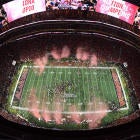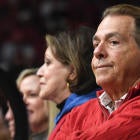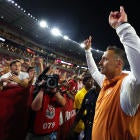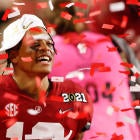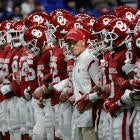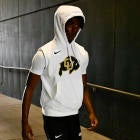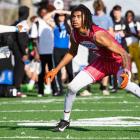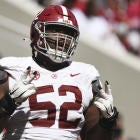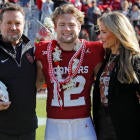College football seems to be one wiretap away from the obvious becoming public: The nation's No. 1 college sport is as crooked, scandalous and cheat-ridden as its basketball counterpart.
That has sort of been forgotten as college hoops' culture continues to be flayed in public.
We've known for decades basketball had a seedy under-the-table aspect to it. The recent revelations from the FBI and media reports of its investigation have filled in the details.
But to think college football is immune to such corruption would be foolish. The sport continues to be the No. 1 economic driver for college athletics. It's just that we've been distracted lately.
The public sure thinks so: I posted a Twitter poll Sunday that revealed 69 percent of voters think scandal/cheating in football is at least as bad as basketball.
The level of cheating/scandal in college football is ...
— Dennis Dodd (@dennisdoddcbs) February 25, 2018
Unscientific? Sure. But the only reason we know about the level of basketball's wrongdoing is the FBI. The bureau was investigating an individual for Security and Exchange Commission violations who was allegedly funneling money to players. That sort of plea-deal whistleblower doesn't exist in college football. Yet.
"It's probably manifested itself in football in a slightly different way," said a former NCAA official familiar with the enforcement process. "… You have the same incentive [to cheat], if not moreso, because of the value of a head coaching job at top level of football.
"I have no doubt [the same level of cheating] is happening."
All of it has opened the NCAA to a different level of criticism. Some argue its arcane amateurism bylaws have created this black market where compensation is the basis for a federal investigation.
Change the rules and those payments -- and least some of them – are suddenly above board. For now, we have to deal with the NCAA's biggest scandal since the 1950s.
The temptation to cheat is certainly there as the structure of football and basketball have become more similar. Salaries, pressure and revenue have never been higher. At certain levels of college football, you even hear of a "going rate" paid for talented recruits. In other words, the amount of cash it would take to the get in the running for a five-star recruit.
With the influence of spread offenses, it's possible -- like basketball -- to change the fortunes of a team with one or two players.
Consider where Clemson would be without Deshaun Watson or Oklahoma without Baker Mayfield. Take the deep threat away from Alabama during its current dynasty run. Would it have won titles without Julio Jones, Amari Cooper and Calvin Ridley?
Editor's note: To be clear, these are just examples of recent impact players on major college football teams. No violations are being alleged.
While college basketball has been fixated on the negative impacts of one-and-done players, freshmen have been impacting football on an increasing basis.
Tua Tagovailoa, anyone? Bama's freshman quarterback won a national championship before he started a game.
Alabama beat Georgia in the College Football Playoff with its leading passer, rusher and pass catcher being freshmen. The numbers have held fairly steady the last decade with 11.3 percent of the top 100 in passing and rushing being freshmen.
"That's one of the major distinctions between football and basketball," that former NCAA official said. "It seemed like it was less likely 10-20 years ago that freshmen come in and make that impact on the football side. Is it the nature of the game that has changed? Is it an earlier development of athlete?"
Steve Clarkson took the opposite side. The noted West Coast quarterback trainer once worked with prospect David Sills when Sills got a USC offer from Lane Kiffin at age 13.
"With football the hardest thing is one guy doesn't make a program," Clarkson said. "There are too many variables whether a kid is going to be successful. You and I have seen kids who are 'can't miss,' but you never hear from them after you write the article."
After a stop at a junior college (once) and West Virginia (twice), Sills changed positions and enters 2018 as an All-American … at wide receiver.
What kind of street agent would have bet on that?
"With football you're talking about so many bodies, there's too much room for slippages," Clarkson said. "There's too many eyeballs. In basketball, it's easier to be discreet."
I wrote two years ago about a more sophisticated level of cheating that had been reached in college football.
Several sources noted the main difference in the two sports: The current FBI investigation has highlighted the agent influence. In college football, the influence is more likely to come from boosters. Players have to wait at least three years to get a crack at NFL riches.
Still, Alabama narrowly dodged the death penalty in one the biggest scandals in college football history. Tide booster Logan Young tried to buy Memphis-area standout defensive lineman Albert Means.
Who can forget Nevin Shapiro at Miami? A quick check of the NCAA legislative database shows that one-third of the major infractions cases this decade involved improper influence by a booster.
The tide shifted in football about a decade ago with the rise of 7-on-7 in the offseason. What formerly was touch football has been monetized by the shoe companies -- sound familiar? -- who now control the major tournament circuit.
What could go wrong?
"In AAU basketball, those are the guys who really control the kids," said UNLV coach Tony Sanchez. "That started to change probably 10 years ago in football with the 7-on-7. There are definitely influences out there."
It's hard to pin down the exact negative of 7-of-7. The most infamous case involved Willie Lyles, who Oregon allegedly paid $25,000 to steer players to the Ducks. Lyles was what the NCAA has come to call a "non-scholastic 7-on-7 coach."
Those sort of shadowy, street-level hustlers are some of the toughest violators for the NCAA to track down.
Sanchez once coached one of the most powerful high school programs in the country. Las Vegas Gorman has facilities better than some FBS schools. Sanchez developed some of the top prospects in the country.
"I remember going down to Nike for a high school coaches' summit," he said. "One of the topics was 7-on-7. Nike was talking about being more involved in it. We were all kind of expressing that it's changing the game a little bit. Kids are either coming back more undisciplined or a little more show boaty."
Our Candid Coaches series in August revealed 57 percent of FBS coaches believe that no more than 10 perfect of teams knowingly cheat.
The outlook for the Power Five -- where more than 75 percent of the major football infractions cases have originated since 2000 -- seems uneven.
Since they voted in autonomy in 2014, we've seen some of the most distasteful scandals in history:
- North Carolina's academic fraud case
- The sex, strippers and FBI portion of the investigation that cost Louisville coach Rick Pitino and athletic director Tom Jurich their jobs
- The ongoing Baylor sexual assault scandal
- The Larry Nassar scandal at Michigan State that has extended into a look at the entire athletic department
- The FBI basketball probe that seems years from completion.
This is the oversight from the Power Five folks who were supposed to take control of things.
The NCAA likely won't dive into any of the current basketball issue until the feds are finished. That's assuming the association has the manpower, will and jurisdiction to do so.
Example: How does the NCAA recreate information obtained from a federal wiretap?
That isn't their information until, say, a Sean Miller admits he indeed solicited the $100,000 for star DeAndre Ayton as has been reported. Good luck with that.
Perhaps all of it means football can relax. For now.







